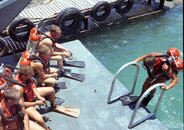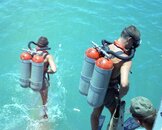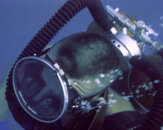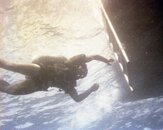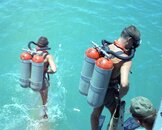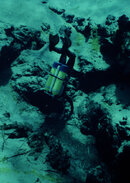These Navy cylinders are in the same situation as foreign code cylinders in the US. They are not stamped or were originally qualified by the DOT. Therefore, they cannot be requalified under the DOT codes.
Requalification of DOT high pressure cylinders require hydro-testing, but
hydro-testing can be physically performed on NAVY and foreign cylinders, without implying that they are going to be requalified under DOT codes.
Bill High and others have made the incorrect statement that they “cannot be hydro-tested”, when what they meant is that they “cannot be requalified under DOT codes”. The two statements are not the same and are not interchangeable. One statement is correct, the other one is not.
A cylinder that was never qualified under DOT codes cannot be requalified under DOT codes… that is a true statement.
Saying that a cylinder “cannot be hydro-tested” just because it cannot be “requalified under DOT code”, is incorrect statement, it is miss-information (and if it is not obvious, spreading that type of miss-information irritates me a lot).
In the US and all over the word hydro-tests of pressure vessels are conducted every day without being under the DOT codes. I have been involved in many non-DOT hydro-tests.
Another common piece of miss-information is that foreign cylinders (and these type of NAVY cylinders) cannot be hydro-tested in a DOT licensed facility. That is false and incorrect. The correct statement is that they can do the test and they can even stamp the test date, but they cannot stamp their DOT RIM number (license number) with the test date.
The testing of foreign pressure vessels happens frequently in international ports (like here in Portland, Maine), were foreign flagged ships have life-rafts with pressure vessels that require their periodic service. We have two companies that are qualified to service foreign life-rafts. They used to bring their foreign cylinders to Maine Divers Scuba center for hydro test. They were hydro-tested using the proper codes and stamped with only the date. This is all approved by the DOT, since these pressure vessels are not used in interstate commerce, they are in international use.
I personally have Swedish Poseidon cylinders and Drager German cylinders that I have hydro tested and stamped the date, but not the DOT license number, because they are not DOT cylinders.
Hydro testing non-DOT cylinders (including the NAVY cylinders) in a DOT facility is perfectly legal as long as they are not stamped with the DOT license number.
Here is a thread (from 2014) were Captain talked about hydro-testing his NAVY cylinders.
USN diver tanks, big about 80 or 90 cu. ft. with a welded plug in the bottom.
Again, let me make it clear:
“DOT requalification requires hydro-testing”, but hydro-testing does not always mean automatic DOT requalification. You can physically hydro test anything!
Luis,
I was a 21 year old when I took those notes. I’m only telling you what I was told by the instructors. I am pretty sure you are correct, that it was a hydrostatic test. But I’m also sure that these cylinders were not for civilian use, and should not be either hydroed or filled now.
SeaRat
John, that (in bold) is your opinion and I totally respect that as your opinion, but it is an opinion...
I am sorry that this thread has been derailed, but I consider it important not to spread miss-information. Specially about vintage scuba cylinders.
I consider this type of miss-information in the same category as the dive shops that claim that 3AA cylinders can never be re-stamped with the + sign. The scuba industry is loaded with miss-information and I personally consider that a message board like this should try to correct that and present facts (not just opinions). It is OK to have opinions, but IMHO they need to be differentiated from the facts.
I am getting off my soap box…
I think it is time for more pictures of pretty girls wearing vintage or goofy scuba gear.

.



